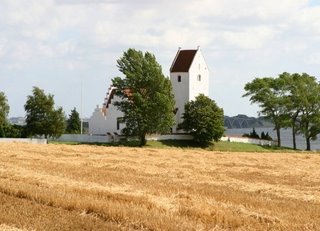 I like the sound of church bells in the morning. You can hear them loud and clear in any wind direction because our church stands on a hill overlooking the Wolf sound only a few hundred metres down the coast. Its nave and choir was built in Romanesque style around 1250 and the church tower was erected in the Gothic period, around 1400. The tower has two huge bells, one made in 1477 and the other in 1618. They sound old, too. Rather unhurried at first because of the wear along the edges, I suppose, but soon boomingly alive as if the metal had dressed to the vibrations over time, defying even the hardest winds and rains. I don’t so much like to hear them in the afternoon. Not because of the beautiful sound, but because of its connotations. The sound of them in the evening brings consolation. It’s as if they were saying: We’re still here after all this time.
I like the sound of church bells in the morning. You can hear them loud and clear in any wind direction because our church stands on a hill overlooking the Wolf sound only a few hundred metres down the coast. Its nave and choir was built in Romanesque style around 1250 and the church tower was erected in the Gothic period, around 1400. The tower has two huge bells, one made in 1477 and the other in 1618. They sound old, too. Rather unhurried at first because of the wear along the edges, I suppose, but soon boomingly alive as if the metal had dressed to the vibrations over time, defying even the hardest winds and rains. I don’t so much like to hear them in the afternoon. Not because of the beautiful sound, but because of its connotations. The sound of them in the evening brings consolation. It’s as if they were saying: We’re still here after all this time.
THE ROAD TO LAGOA SANTA Only one man of world prominence is buried in the cemetery surrounding the church. Henrik Stangerup is perhaps the most well known modern Danish novelist after Peter Høeg and Thorkild Hansen. It might not mean much to most people, but I was glad to meet him at the vicarage in the year before he died, because I've always admired his work. The Road to Lagoa Santa (1981) is his best book, I think. It's a historical novel, which deals with Søren Kierkegaard's thoughts on ethics. The plot is somewhat like the first half of an Indiana Jones story with the hero dying when he finds the proof of his theory. I'm not giving away anything because he's a historical figure whose fate was already known to the Danish readers when the book came out. Henrik Stangerup wrote very well and had a great gift for rambling, I think, although I can't speak for the English editions.
Only one man of world prominence is buried in the cemetery surrounding the church. Henrik Stangerup is perhaps the most well known modern Danish novelist after Peter Høeg and Thorkild Hansen. It might not mean much to most people, but I was glad to meet him at the vicarage in the year before he died, because I've always admired his work. The Road to Lagoa Santa (1981) is his best book, I think. It's a historical novel, which deals with Søren Kierkegaard's thoughts on ethics. The plot is somewhat like the first half of an Indiana Jones story with the hero dying when he finds the proof of his theory. I'm not giving away anything because he's a historical figure whose fate was already known to the Danish readers when the book came out. Henrik Stangerup wrote very well and had a great gift for rambling, I think, although I can't speak for the English editions.

0 Comments:
Post a Comment
<< Home